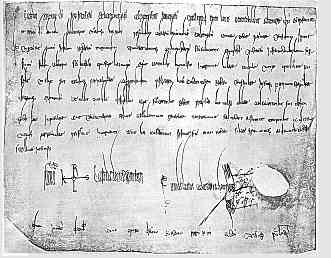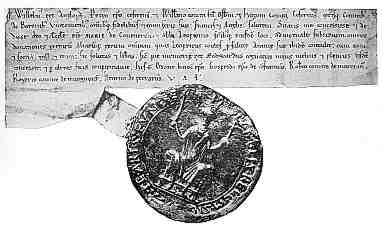


If you are looking at this page without frames, there is more information about medieval writing to be found by going to the home page (framed) or the site map (no frames).
| Diplomatic (without tears) | |||
| Diplomatic is the study of the form and structure of documents, deriving from the term diploma used to designate the most formal grade of legal documents on the continent of Europe. It can be a highly detailed and intricate art which allows documents to be provenanced with some accuracy, and which can be used for the detection of forgeries. Knowledge of the diplomatic of a class of documents enables the reader to decode them more easily, and to separate the purely ceremonial language, often highly formularised, from the individualised information in the document. | |||
| The term diplomatic tends to be used in relation to very formal documents such as royal charters or papal bulls, but the basic principle can be applied to any class of document. Every type of document has its particular characteristics. This is not merely stylistic conservatism by the drafters of such documents, but serves as part of the symbolic language of validation. If it looks in every detail like it is supposed to, then it is probably what it is supposed to be. Modern scholars sniff out diplomatic anomalies to detect forgeries, and no doubt medieval experts did the same. | |||
 |
|||
| Diploma of Charlemagne of AD 781 (Marburg, K. Preussisches Staatsarchiv). (From Steffens 1929) | |||
| The diploma of Charlemagne shown above has not only a particular form of words, but also a series of graphic elements laid out in a particular pattern. There is a Chrismon symbol in the top left, a monogram of the king's name below the main text, followed by his written name. By this time it was no longer an autograph signature. To the right is an inscription and an autograph graphic sign of the royal notary. The blank circular space shows where the seal was formerly attached to the face of the document. Along the bottom is the dating clause. When we look at the words, we discover that these also have particular formal qualities. | |||
 |
Charter of William I of c.1070 to the church of St Mary at Coventry (British Library, add charter 11205). (From Johnson and Jenkinson 1915) | ||
| A charter of William I of England has a completely different look. The text is relatively brief and the language rather less florid. There are no complicated graphic validating insignia, but rather a very hefty double sided seal bearing images of the king, attached to a strip of parchment cut from the base of the document. There is no date written on this document. | |||
 |
Once again ignoring for the moment the very important form of words, this papal bull displays certain elements of layout that identify it even if you cannot read it. It has a tall, laterally compressed heading at the top, the graphic sign manual of the pope below the main text beside his signature and a monogram representing the words BENE VALETE, followed by the dating clause. Below this the names of witnesses are entered, each beside an autograph cross. The distinctive leaden seal, or bulla (not shown) is attached with silken cords. | ||
| Papal bull of Pope Eugenius III, of 1147 (British Library, Cotton Cleopatra E I, f,123). (From New Palaeographical Society 1904) | |||
| So far we have only perused the graphical and layout aspects of diplomatic. The form of words is also significant, and varies between different classes of document, and within the same class of document over time. These will be examined in more detail for various different classes of document. | |||
| Meanwhile, it is not only royal or papal diplomas that display defined formal qualities of layout and style. The same characteristics can be examined and compared for documents of a simpler nature. | |||
|
|
|||
|
|
|||
|
If you are looking at this page without frames, there is more information about medieval writing to be found by going to the home page (framed) or the site map (no frames). |
|||